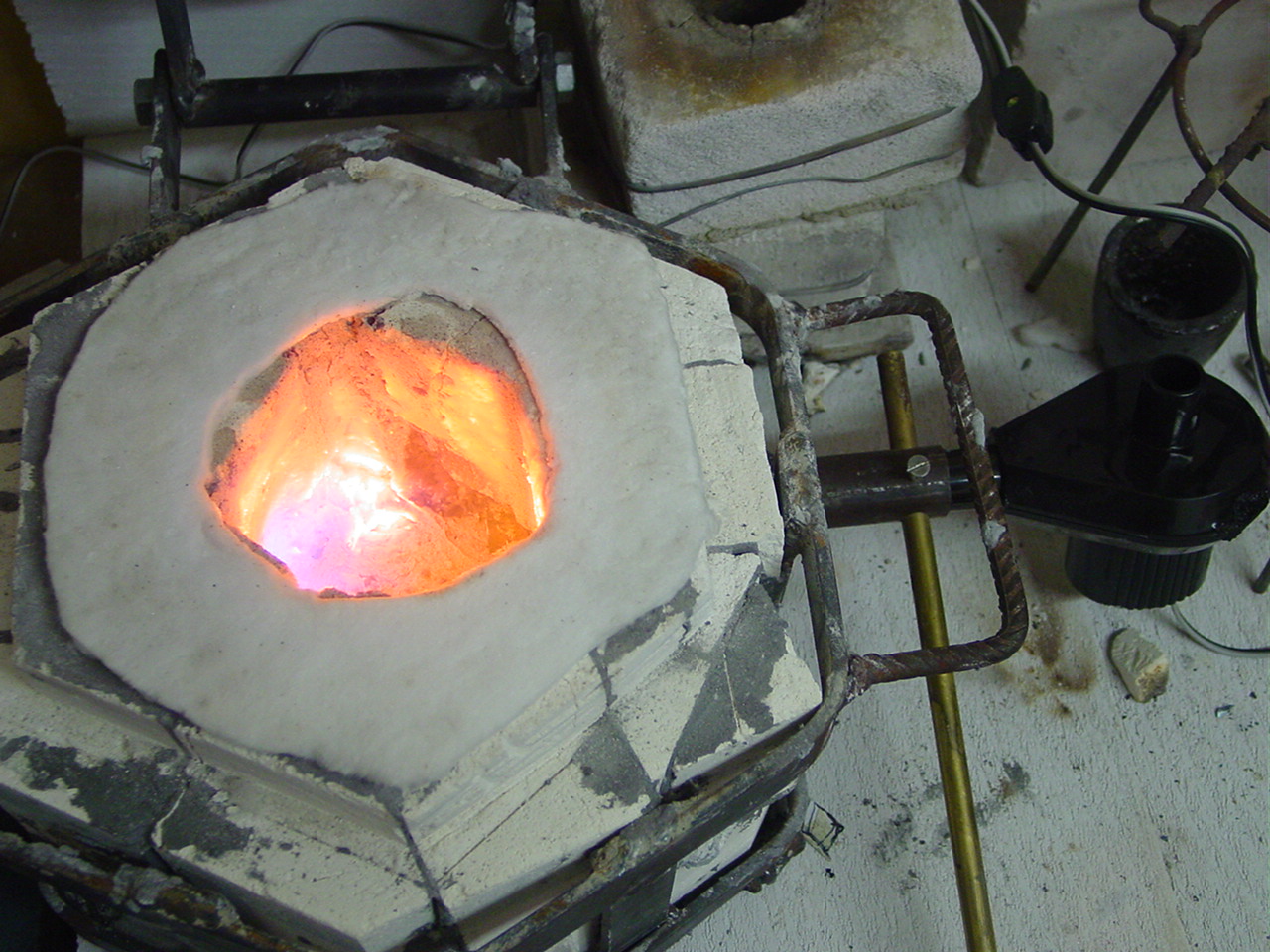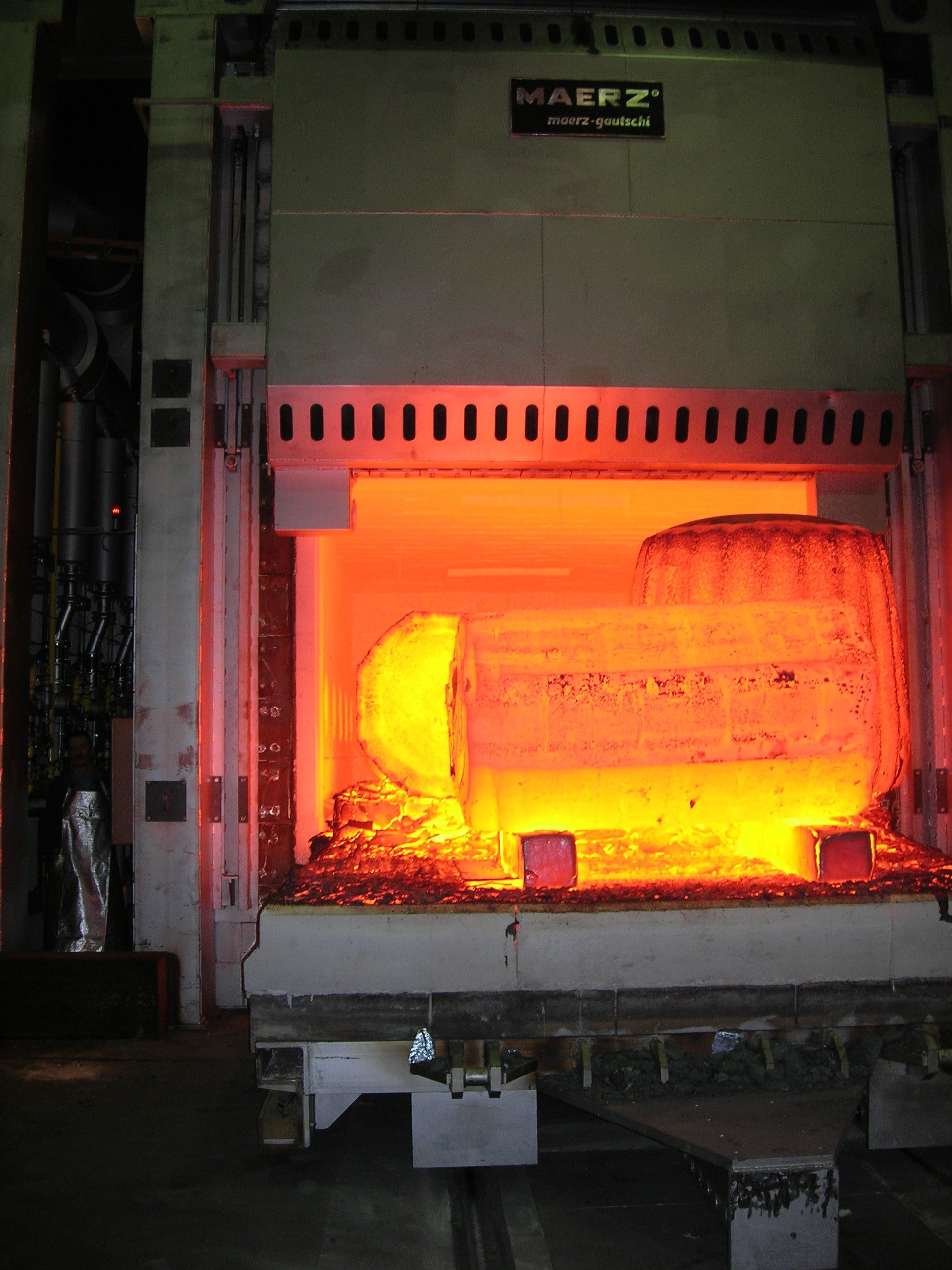|
Single Ended Recuperative Burner
A single-ended recuperative (SER) burner is a type of gas burner used in high-temperature industrial kilns and furnaces. These burners are used where indirect heating is required, e.g. where the products of combustion are not allowed to combine with the atmosphere of the furnace. The typical design is a tubular (pipe) shape with convoluted pathways on the interior, closed on the end pointed into the furnace. A gas burner fires a flame down the center of these pathways, and the hot combustion gases are then forced to change direction and travel along the shell of the tube, heating it to incandescent temperatures and allowing efficient transfer of thermal energy to the furnace interior. Exhaust gas is collected back at the burner end where it is eventually discharged to the atmosphere. The hot exhaust can be used to pre-heat the incoming combustion air and fuel gas (recuperation) to boost efficiency. Such burners compete with electrical heating and can be more economical to operate tha ... [...More Info...] [...Related Items...] OR: [Wikipedia] [Google] [Baidu] |
Gas Burner
A gas burner is a device that produces a controlled flame by mixing a fuel gas such as acetylene, natural gas, or propane with an oxidizer such as the ambient air or supplied oxygen, and allowing for ignition and combustion. The flame is generally used for the heat, infrared radiation, or visible light it produces. Some burners, such as gas flares, dispose of unwanted or uncontainable flammable gases. Some burners are operated to produce carbon black. The gas burner has many applications such as soldering, brazing, and welding, the latter using oxygen instead of air for producing a hotter flame, which is required for melting steel. Chemistry laboratories use natural-gas fueled Bunsen burners. In domestic and commercial settings gas burners are commonly used in gas stoves and cooktops. For melting metals with melting points of up to 1100 °C (such as copper, silver, and gold Gold is a chemical element with the symbol Au (from la, aurum) and atomic number 79. This ... [...More Info...] [...Related Items...] OR: [Wikipedia] [Google] [Baidu] |
Kilns
A kiln is a thermally insulated chamber, a type of oven, that produces temperatures sufficient to complete some process, such as hardening, drying, or chemical changes. Kilns have been used for millennia to turn objects made from clay into pottery, tiles and bricks. Various industries use rotary kilns for pyroprocessing—to calcinate ores, to calcinate limestone to lime for cement, and to transform many other materials. Pronunciation and etymology According to the Oxford English Dictionary, kiln was derived from the words cyline, cylene, cyln(e) in Old English, in turn derived from Latin ''culina'' ("kitchen"). In Middle English the word is attested as kulne, kyllne, kilne, kiln, kylle, kyll, kil, kill, keele, kiele. For over 600 years, the final "n" in kiln was silent. It wasn't until the late 20th century where the "n" began to be pronounced. This is due to a phenomenon known as spelling pronunciation, where the pronunciation of a word is surmised from its spelling an ... [...More Info...] [...Related Items...] OR: [Wikipedia] [Google] [Baidu] |
Industrial Furnace
An industrial furnace, also known as a direct heater or a direct fired heater, is a device used to provide heat for an industrial process, typically higher than 400 degrees Celsius. They are used to provide heat for a process or can serve as reactor which provides heats of reaction. Furnace designs vary as to its function, heating duty, type of fuel and method of introducing combustion air. Heat is generated by an industrial furnace by mixing fuel with air or oxygen, or from electrical energy. The residual heat will exit the furnace as flue gas. These are designed as per international codes and standards the most common of which are ISO 13705 (Petroleum and natural gas industries — Fired heaters for general refinery service) / American Petroleum Institute (API) Standard 560 (Fired Heater for General Refinery Service). Types of industrial furnaces include batch ovens, vacuum furnaces, and solar furnaces. Industrial furnaces are used in applications such as chemical reactions, ... [...More Info...] [...Related Items...] OR: [Wikipedia] [Google] [Baidu] |
Combustion
Combustion, or burning, is a high-temperature exothermic redox chemical reaction between a fuel (the reductant) and an oxidant, usually atmospheric oxygen, that produces oxidized, often gaseous products, in a mixture termed as smoke. Combustion does not always result in fire, because a flame is only visible when substances undergoing combustion vaporize, but when it does, a flame is a characteristic indicator of the reaction. While the activation energy must be overcome to initiate combustion (e.g., using a lit match to light a fire), the heat from a flame may provide enough energy to make the reaction self-sustaining. Combustion is often a complicated sequence of elementary radical reactions. Solid fuels, such as wood and coal, first undergo endothermic pyrolysis to produce gaseous fuels whose combustion then supplies the heat required to produce more of them. Combustion is often hot enough that incandescent light in the form of either glowing or a flame is produced. A ... [...More Info...] [...Related Items...] OR: [Wikipedia] [Google] [Baidu] |
Atmosphere
An atmosphere () is a layer of gas or layers of gases that envelop a planet, and is held in place by the gravity of the planetary body. A planet retains an atmosphere when the gravity is great and the temperature of the atmosphere is low. A stellar atmosphere is the outer region of a star, which includes the layers above the opaque photosphere; stars of low temperature might have outer atmospheres containing compound molecules. The atmosphere of Earth is composed of nitrogen (78%), oxygen (21%), argon (0.9%), carbon dioxide (0.04%) and trace gases. Most organisms use oxygen for respiration; lightning and bacteria perform nitrogen fixation to produce ammonia that is used to make nucleotides and amino acids; plants, algae, and cyanobacteria use carbon dioxide for photosynthesis. The layered composition of the atmosphere minimises the harmful effects of sunlight, ultraviolet radiation, the solar wind, and cosmic rays to protect organisms from genetic damage. The current comp ... [...More Info...] [...Related Items...] OR: [Wikipedia] [Google] [Baidu] |
Exhaust Gas
Exhaust gas or flue gas is emitted as a result of the combustion of fuels such as natural gas, gasoline (petrol), diesel fuel, fuel oil, biodiesel blends, or coal. According to the type of engine, it is discharged into the atmosphere through an exhaust pipe, flue gas stack, or propelling nozzle. It often disperses downwind in a pattern called an ''exhaust plume''. It is a major component of motor vehicle emissions (and from stationary internal combustion engines), which can also include crankcase blow-by and evaporation of unused gasoline. Motor vehicle emissions contribute to air pollution and are a major ingredient in the creation of smog in some large cities. A 2013 study by the Massachusetts Institute of Technology (MIT) indicates that 53,000 early deaths occur per year in the United States alone because of vehicle emissions. According to another study from the same university, traffic fumes alone cause the death of 5,000 people every year just in the United Kingdom. Comp ... [...More Info...] [...Related Items...] OR: [Wikipedia] [Google] [Baidu] |
Electrical Heating
Electric heating is a process in which electrical energy is converted directly to heat energy at around 100% efficiency, using rather cheap devices. Common applications include space heating, cooking, water heating and industrial processes. An electric heater is an electrical device that converts an electric current into heat. The heating element inside every electric heater is an electrical resistor, and works on the principle of Joule heating: an electric current passing through a resistor will convert that electrical energy into heat energy. Most modern electric heating devices use nichrome wire as the active element; the heating element, depicted on the right, uses nichrome wire supported by ceramic insulators. Alternatively, a heat pump can achieve around 300% efficiency for heating, or 3.0 Coefficient of performance, because it uses electric power only for transferring existing thermal energy from the surrounding area, mostly air. The heat pump uses an electric motor to dr ... [...More Info...] [...Related Items...] OR: [Wikipedia] [Google] [Baidu] |
Natural Gas
Natural gas (also called fossil gas or simply gas) is a naturally occurring mixture of gaseous hydrocarbons consisting primarily of methane in addition to various smaller amounts of other higher alkanes. Low levels of trace gases like carbon dioxide, nitrogen, hydrogen sulfide, and helium are also usually present. Natural gas is colorless and odorless, so odorizers such as mercaptan (which smells like sulfur or rotten eggs) are commonly added to natural gas supplies for safety so that leaks can be readily detected. Natural gas is a fossil fuel and non-renewable resource that is formed when layers of organic matter (primarily marine microorganisms) decompose under anaerobic conditions and are subjected to intense heat and pressure underground over millions of years. The energy that the decayed organisms originally obtained from the sun via photosynthesis is stored as chemical energy within the molecules of methane and other hydrocarbons. Natural gas can be burned fo ... [...More Info...] [...Related Items...] OR: [Wikipedia] [Google] [Baidu] |





